Assessing the Hydrologic Response of a Major Drinking Water Reservoir to Extreme Flood Events and Climate Change Using SWAT and OASIS
Abstract
:1. Introduction
2. Study Area
3. Modeling Approach
3.1. Preprocessing of Climate Projection
3.2. OASIS: Initial Reservoir Elevation Setting during Synthetic Hurricanes and Winter Storm
4. Result and Discussion
4.1. SWAT Calibration and Validation
4.2. OASIS Calibration and Validation
4.3. Reservoir Response to RCP4.5 and RCP8.5 Projections
4.4. Comparison of Reservoir Impact on Flooding during Hurricane Events
5. Conclusions
Supplementary Materials
Author Contributions
Funding
Data Availability Statement
Acknowledgments
Conflicts of Interest
References
- Vahedifard, F.; Madani, K.; AghaKouchak, A.; Thota, S.K. Are We Ready for More Dam Removals in the United States. Environ. Res. Infrastruct. Sustain. 2021, 1, 013001. [Google Scholar] [CrossRef]
- National Climate Data Center. Billion-Dollar Weather and Climate Disasters; National Climate Data Center (NCDC): Asheville, NC, USA, 2017. [Google Scholar]
- American Society of Civil Engineers. Report Card on America’s Infrastructure: Dams; The American Society of Civil Engineers (ASCE): Washington, DC, USA, 2017. [Google Scholar]
- Robinson, J.D.; Vahedifard, F.; AghaKouchak, A. Rainfall-Triggered Slope Instabilities under a Changing Climate: Comparative Study Using Historical and Projected Precipitation Extremes. Can. Geotech. J. 2017, 54, 117–127. [Google Scholar] [CrossRef]
- Hayhoe, K.; Wake, C.P.; Huntington, T.G.; Luo, L.; Schwartz, M.D.; Sheffield, J.; Wood, E.; Anderson, B.; Bradbury, J.; DeGaetano, A. Past and Future Changes in Climate and Hydrological Indicators in the US Northeast. Clim. Dyn. 2007, 28, 381–407. [Google Scholar] [CrossRef]
- Huntington, T.G.; Richardson, A.D.; McGuire, K.J.; Hayhoe, K. Climate and Hydrological Changes in the Northeastern United States: Recent Trends and Implications for Forested and Aquatic Ecosystems. Can. J. For. Res. 2009, 39, 199–212. [Google Scholar] [CrossRef]
- Keim, B.D.; Rock, B. Chapter 2—The New England Region’s Changing Climate. In Preparing for a Changing Climate: The Potential Consequences of Climate Variability and Change. The New England Regional Assessment Overview; The U.S. Global Change Research Program; University of New Hampshire: Durham, NH, USA, 2001; pp. 8–17. [Google Scholar]
- Hodgkins, G.A.; Dudley, R.W. Changes in the Timing of Winter–Spring Streamflows in Eastern North America, 1913–2002. Geophys. Res. Lett. 2006, 33, L06402. [Google Scholar] [CrossRef]
- Burakowski, E.A.; Wake, C.P.; Braswell, B.; Brown, D.P. Trends in Wintertime Climate in the Northeastern United States: 1965–2005. J. Geophys. Res. Atmos. 2008, 113, D20114. [Google Scholar] [CrossRef]
- Rustad, L.E.; Campbell, J.; Dukes, J.S.; Huntington, T.; Lambert, K.F.; Mohan, J.; Rodenhouse, N. Changing Climate, Changing Forests: The Impacts of Climate Change on Forests of the Northeastern United States and Eastern Canada; US Department of Agriculture, Forest Service, Northern Research Station: Newtown Square, PA, USA, 2012; ISBN 1505826985. [Google Scholar]
- Homer, C.; Dewitz, J.; Jin, S.; Xian, G.; Costello, C.; Danielson, P.; Gass, L.; Funk, M.; Wickham, J.; Stehman, S. Conterminous United States Land Cover Change Patterns 2001–2016 from the 2016 National Land Cover Database. ISPRS J. Photogramm. Remote Sens. 2020, 162, 184–199. [Google Scholar] [CrossRef]
- Hartley, S.; Dingman, S.L. Effects of Climatic Variability on Winter-Spring Runoff in New England River Basins. Phys. Geogr. 1993, 14, 379–393. [Google Scholar] [CrossRef]
- Morang, A. Hurricane Barriers in New England and New Jersey: History and Status after Five Decades. J. Coast. Res. 2016, 32, 181–205. [Google Scholar] [CrossRef]
- Schlichting, K.M. Misremembering Risk in the Age of Hurricanes: The Rhode Island Coast in the 1930s–1950s. Coast. Stud. Soc. 2022, 1, 10–33. [Google Scholar] [CrossRef]
- Zarriello, P.J.; Ahearn, E.A.; Levin, S.B. Magnitude of Flood Flows for Selected Annual Exceedance Probabilities in Rhode Island through 2010; US Geological Survey: Reston, VA, USA, 2012. [Google Scholar]
- Burke, J.L. The Great Flood of 2010: A Municipal Response. J. N. Engl. Water Work. Assoc. 2012, 126, 230. [Google Scholar]
- Hashemi, M.R.; Kouhi, S.; Kian, R.; Spaulding, M.; Steele, S.; Damon, C.; Boyd, J. Integrated Watershed and River Modeling Study of the Pawtuxet River; University of Rhode Island: Narragansett, RI, USA, 2017. [Google Scholar]
- National Academies of Science, Engineering, and Medicine (NASEM). Review of the New York City Department of Environmental Protection Operations Support Tool for Water Supply; The National Academies Press: Washington, DC, USA, 2019. [Google Scholar] [CrossRef]
- Rush, P.V.; Murphy, T.; Mayer, R.A.; Johnstone, T.; Olivio, D.; Woods, H.J. Water System Safe Yield Calculation; New York City Department of Environmental Protection: New York, NY, USA, 2011. [Google Scholar]
- Rossi, N.; DeCristofaro, L.; Steinschneider, S.; Brown, C.; Palmer, R. Potential Impacts of Changes in Climate on Turbidity in New York City’s Ashokan Reservoir. J. Water. Resour. Plan. Manag. 2016, 142, 04015066. [Google Scholar] [CrossRef]
- Gelda, R.K.; Mukundan, R.; Matonse, A.H.; Owens, E.M.; Mead, J. Assessment of Climate Change Impacts on New York City Water Supply System. In World Environmental and Water Resources Congress 2020; American Society of Civil Engineers: Reston, VA, USA, 2020; pp. 152–166. [Google Scholar]
- Rivera, M.; Nebiker, S.; Wright, B. Dynamic Reservoir Operations Support Sustainable Water Management. Opflow 2016, 42, 12–16. [Google Scholar] [CrossRef]
- Stephenson, D. Water Resource Management, 1st ed.; CRC Press: London, UK, 2003; Volume 336. [Google Scholar] [CrossRef]
- Neitsch, S.L.; Arnold, J.G.; Kiniry, J.R.; Srinivasan, R.; Williams, J.R. Soil and Water Assessment Tool User’s Manual; Texas Water Resources Institute: College Station, TX, USA, 2002. [Google Scholar]
- Gassman, P.W.; Reyes, M.R.; Green, C.H.; Arnold, J.G. The Soil and Water Assessment Tool: Historical Development, Applications, and Future Research Directions. Trans. ASABE 2007, 50, 1211–1250. [Google Scholar] [CrossRef]
- Shaabani, M.K.; Abedi-Koupai, J.; Eslamian, S.S.; Gohari, S.A.R. Simulation of the Effects of Climate Change, Crop Pattern Change, and Developing Irrigation Systems on the Groundwater Resources by SWAT, WEAP and MODFLOW Models: A Case Study of Fars Province, Iran. Environ. Dev. Sustain. 2024, 26, 10485–10511. [Google Scholar] [CrossRef]
- Xu, Z.X.; Pang, J.P.; Liu, C.M.; Li, J.Y. Assessment of Runoff and Sediment Yield in the Miyun Reservoir Catchment by Using SWAT Model. Hydrol. Process. Int. J. 2009, 23, 3619–3630. [Google Scholar] [CrossRef]
- Hunink, J.E.; Niadas, I.A.; Antonaropoulos, P.; Droogers, P.; De Vente, J. Targeting of Intervention Areas to Reduce Reservoir Sedimentation in the Tana Catchment (Kenya) Using SWAT. Hydrol. Sci. J. 2013, 58, 600–614. [Google Scholar] [CrossRef]
- Liu, X.; Yang, M.; Meng, X.; Wen, F.; Sun, G. Assessing the Impact of Reservoir Parameters on Runoff in the Yalong River Basin Using the SWAT Model. Water 2019, 11, 643. [Google Scholar] [CrossRef]
- Al-Ansari, N.; Ezz-Aldeen, M.; Knutsson, S. Application of Swat Model to Estimate the Sediment Load from the Left Bank of Mosul Dam. J. Adv. Sci. Eng. Res. 2013, 3, 47–61. [Google Scholar]
- Mishra, A.; Froebrich, J.; Gassman, P.W. Evaluation of the SWAT Model for Assessing Sediment Control Structures in a Small Watershed in India. Trans. ASABE 2007, 50, 469–477. [Google Scholar] [CrossRef]
- Licciardello, F.; Toscano, A.; Cirelli, G.L.; Consoli, S.; Barbagallo, S. Evaluation of Sediment Deposition in a Mediterranean Reservoir: Comparison of Long Term Bathymetric Measurements and SWAT Estimations. Land Degrad. Dev. 2017, 28, 566–578. [Google Scholar] [CrossRef]
- Gessese, A.; Yonas, M. Prediction of Sediment Inflow to Legedadi Reservoir Using SWAT Watershed and CCHE1D Sediment Transport Models. Nile Basin Water Eng. Sci. Mag. 2008, 1, 65–74. [Google Scholar]
- Afshar, A.A.; Hassanzadeh, Y. Determination of Monthly Hydrological Erosion Severity and Runoff in Torogh Dam Watershed Basin Using SWAT and WEPP Models. Iran. J. Sci. Technol. Trans. Civ. Eng. 2017, 41, 221–228. [Google Scholar] [CrossRef]
- Lee, J.; Lee, Y.; Woo, S.; Kim, W.; Kim, S. Evaluation of Water Quality Interaction by Dam and Weir Operation Using SWAT in the Nakdong River Basin of South Korea. Sustainability 2020, 12, 6845. [Google Scholar] [CrossRef]
- Nazari-Sharabian, M.; Taheriyoun, M. Climate Change Impact on Water Quality in the Integrated Mahabad Dam Watershed-Reservoir System. J. Hydro-Environ. Res. 2022, 40, 28–37. [Google Scholar] [CrossRef]
- Chou, F.N.F.; Wu, C.W. Stage-Wise Optimizing Operating Rules for Flood Control in a Multi-Purpose Reservoir. J. Hydrol. 2015, 521, 245–260. [Google Scholar] [CrossRef]
- Hsu, N.S.; Wei, C.C. A Multipurpose Reservoir Real-Time Operation Model for Flood Control during Typhoon Invasion. J. Hydrol. 2007, 336, 282–293. [Google Scholar] [CrossRef]
- Turner, S.W.D.; Bennett, J.; Robertson, D.; Galelli, S. Value of Seasonal Streamflow Forecasts in Emergency Response Reservoir Management. Hydrol. Earth Syst. Sci. Discuss. 2017, 691, 1–26. [Google Scholar] [CrossRef]
- Montaldo, N.; Mancini, M.; Rosso, R. Flood Hydrograph Attenuation Induced by a Reservoir System: Analysis with a Distributed Rainfall-Runoff Model. Hydrol. Process. 2004, 18, 545–563. [Google Scholar] [CrossRef]
- Prasanchum, H.; Kangrang, A. Optimal Reservoir Rule Curves under Climatic and Land Use Changes for Lampao Dam Using Genetic Algorithm. KSCE J. Civ. Eng. 2018, 22, 351–364. [Google Scholar] [CrossRef]
- Sun, Y.; Zhang, W.; Peng, H.; Zhou, F.; Jiang, A.; Chen, X.; Wang, H. The Impacts of Climate Change on the Hydrological Process and Water Quality in the Three Gorges Reservoir Area, China. Water 2023, 15, 1542. [Google Scholar] [CrossRef]
- Taye, M.T.; Ebrahim, G.Y.; Nigussie, L.; Hagos, F.; Uhlenbrook, S.; Schmitter, P. Integrated Water Availability Modelling to Assess Sustainable Agricultural Intensification Options in the Meki Catchment, Central Rift Valley, Ethiopia. Hydrol. Sci. J. 2022, 67, 2271–2293. [Google Scholar] [CrossRef]
- Wu, J.; Yen, H.; Arnold, J.G.; Yang, Y.C.E.; Cai, X.; White, M.J.; Santhi, C.; Miao, C.; Srinivasan, R. Development of Reservoir Operation Functions in SWAT+ for National Environmental Assessments. J. Hydrol. 2020, 583, 124556. [Google Scholar] [CrossRef]
- Jordan, S.; Quinn, J.; Zaniolo, M.; Giuliani, M.; Castelletti, A. Advancing Reservoir Operations Modelling in SWAT to Reduce Socio-Ecological Tradeoffs. Environ. Model. Softw. 2022, 157, 105527. [Google Scholar] [CrossRef]
- Zhang, X.; Xu, Y.-P.; Fu, G. Uncertainties in SWAT Extreme Flow Simulation under Climate Change. J. Hydrol. 2014, 515, 205–222. [Google Scholar] [CrossRef]
- Hamid, A.T.; Sharif, M.; Narsimlu, B. Assessment of Climate Change Impacts on Streamflows in Satluj River Basin, India Using SWAT Model. Int. J. Hydrol. Sci. Technol. 2017, 7, 134–157. [Google Scholar] [CrossRef]
- Easton, Z.M.; Fuka, D.R.; White, E.D.; Collick, A.S.; Biruk Ashagre, B.; McCartney, M.; Awulachew, S.B.; Ahmed, A.A.; Steenhuis, T.S. A Multi Basin SWAT Model Analysis of Runoff and Sedimentation in the Blue Nile, Ethiopia. Hydrol. Earth Syst. Sci. 2010, 14, 1827–1841. [Google Scholar] [CrossRef]
- Thongwan, T.; Kangrang, A.; Techarungreungsakul, R.; Ngamsert, R. Future Inflow under Land Use and Climate Changes and Participation Process into the Medium-Sized Reservoirs in Thailand. Adv. Civ. Eng. 2020, 2020, 812530. [Google Scholar] [CrossRef]
- Kangrang, A.; Prasanchum, H.; Sriworamas, K.; Ashrafi, S.M.; Hormwichian, R.; Techarungruengsakul, R.; Ngamsert, R. Application of Optimization Techniques for Searching Optimal Reservoir Rule Curves: A Review. Water 2023, 15, 1669. [Google Scholar] [CrossRef]
- Chen, S.; Li, Y.; Shin, J.; Kim, T. Constructing Confidence Intervals of Extreme Rainfall Quantiles Using Bayesian, Bootstrap, and Profile Likelihood Approaches. Sci. China Technol. Sci. 2016, 59, 573–585. [Google Scholar] [CrossRef]
- Turner, S.W.D.; Bennett, J.C.; Robertson, D.E.; Galelli, S. Complex Relationship between Seasonal Streamflow Forecast Skill and Value in Reservoir Operations. Hydrol. Earth Syst. Sci. 2017, 21, 4841–4859. [Google Scholar] [CrossRef]
- Nimiroski, M.T.; Waldron, M.C. Sources of Sodium and Chloride in the Scituate Reservoir Drainage Basin, Rhode Island; US Department of the Interior, US Geological Survey: Reston, VA, USA, 2002. [Google Scholar]
- Hodgkins, G.A.; Dudley, R.W.; Huntington, T.G. Changes in the Timing of High River Flows in New England over the 20th Century. J. Hydrol. 2003, 278, 244–252. [Google Scholar] [CrossRef]
- Bent, G.C.; Lombard, P.J. Flood-Inundation Maps for the Pawtuxet River in West Warwick, Warwick, and Cranston, Rhode Island; US Geological Survey: Reston, VA, USA, 2018. [Google Scholar]
- Wild, E.C.; Nimiroski, M.T. Estimated Water Use and Availability in the Pawtuxet and Quinebaug River Basins, Rhode Island, 1995–1999; US Geological Survey: Reston, VA, USA, 2007. [Google Scholar]
- Shin, S.; Pokhrel, Y.; Yamazaki, D.; Huang, X.; Torbick, N.; Qi, J.; Pattanakiat, S.; Ngo-Duc, T.; Nguyen, T.D. High Resolution Modeling of River-floodplain-reservoir Inundation Dynamics in the Mekong River Basin. Water Resour. Res. 2020, 56, e2019WR026449. [Google Scholar] [CrossRef]
- Stern, H.; Davidson, N.E. Trends in the Skill of Weather Prediction at Lead Times of 1–14 Days. Q. J. R. Meteorol. Soc. 2015, 141, 2726–2736. [Google Scholar] [CrossRef]
- Findell, K.L.; Sutton, R.; Caltabiano, N.; Brookshaw, A.; Heimbach, P.; Kimoto, M.; Osprey, S.; Smith, D.; Risbey, J.S.; Wang, Z. Explaining and Predicting Earth System Change: A World Climate Research Programme Call to Action. Bull. Am. Meteorol. Soc. 2023, 104, E325–E339. [Google Scholar] [CrossRef]
- Tokarska, K.B.; Stolpe, M.B.; Sippel, S.; Fischer, E.M.; Smith, C.J.; Lehner, F.; Knutti, R. Past Warming Trend Constrains Future Warming in CMIP6 Models. Sci. Adv. 2020, 6, eaaz9549. [Google Scholar] [CrossRef] [PubMed]
- Pierce, D.W.; Cayan, D.R.; Maurer, E.P.; Abatzoglou, J.T.; Hegewisch, K.C. Improved Bias Correction Techniques for Hydrological Simulations of Climate Change. J. Hydrometeorol. 2015, 16, 2421–2442. [Google Scholar] [CrossRef]
- Pierce, D.W.; Cayan, D.R.; Thrasher, B.L. Statistical Downscaling Using Localized Constructed Analogs (LOCA). J. Hydrometeorol. 2014, 15, 2558–2585. [Google Scholar] [CrossRef]
- Pierce, D.W.; Cayan, D.R.; Feldman, D.R.; Risser, M.D. Future Increases in North American Extreme Precipitation in CMIP6 Downscaled with LOCA. J. Hydrometeorol. 2023, 24, 951–975. [Google Scholar] [CrossRef]
- Dosio, A.; Paruolo, P.; Rojas, R. Bias Correction of the ENSEMBLES High Resolution Climate Change Projections for Use by Impact Models: Analysis of the Climate Change Signal. J. Geophys. Res. Atmos. 2012, 117, D16106. [Google Scholar] [CrossRef]
- Piani, C.; Weedon, G.P.; Best, M.; Gomes, S.M.; Viterbo, P.; Hagemann, S.; Haerter, J.O. Statistical Bias Correction of Global Simulated Daily Precipitation and Temperature for the Application of Hydrological Models. J. Hydrol. 2010, 395, 199–215. [Google Scholar] [CrossRef]
- Walton, D.; Berg, N.; Pierce, D.; Maurer, E.; Hall, A.; Lin, Y.; Rahimi, S.; Cayan, D. Understanding Differences in California Climate Projections Produced by Dynamical and Statistical Downscaling. J. Geophys. Res. Atmos. 2020, 125, e2020JD032812. [Google Scholar] [CrossRef]
- Gudmundsson, L.; Bremnes, J.B.; Haugen, J.E.; Skaugen, T.E. Downscaling RCM Precipitation to the Station Scale Using Quantile Mapping–a Comparison of Methods. Hydrol. Earth Syst. Sci. Discuss. 2012, 9, 6185–6201. [Google Scholar]
- Kershaw, T.; Eames, M.; Coley, D. Assessing the Risk of Climate Change for Buildings: A Comparison between Multi-Year and Probabilistic Reference Year Simulations. Build Environ. 2011, 46, 1303–1308. [Google Scholar] [CrossRef]
- Moriasi, D.N.; Arnold, J.G.; Van Liew, M.W.; Bingner, R.L.; Harmel, R.D.; Veith, T.L. Model Evaluation Guidelines for Systematic Quantification of Accuracy in Watershed Simulations. Trans ASABE 2007, 50, 885–900. [Google Scholar] [CrossRef]
- Paul, S.; Pradhanang, S.M.; Boving, T.B. Assessing the Reservoir Inflow Relationship for Effective Flood Mitigation: A Hydrologic Modeling Approach for Scituate Reservoir, Rhode Island. J. N. Engl. Water Work. Assoc. 2024, 138, 49. [Google Scholar]

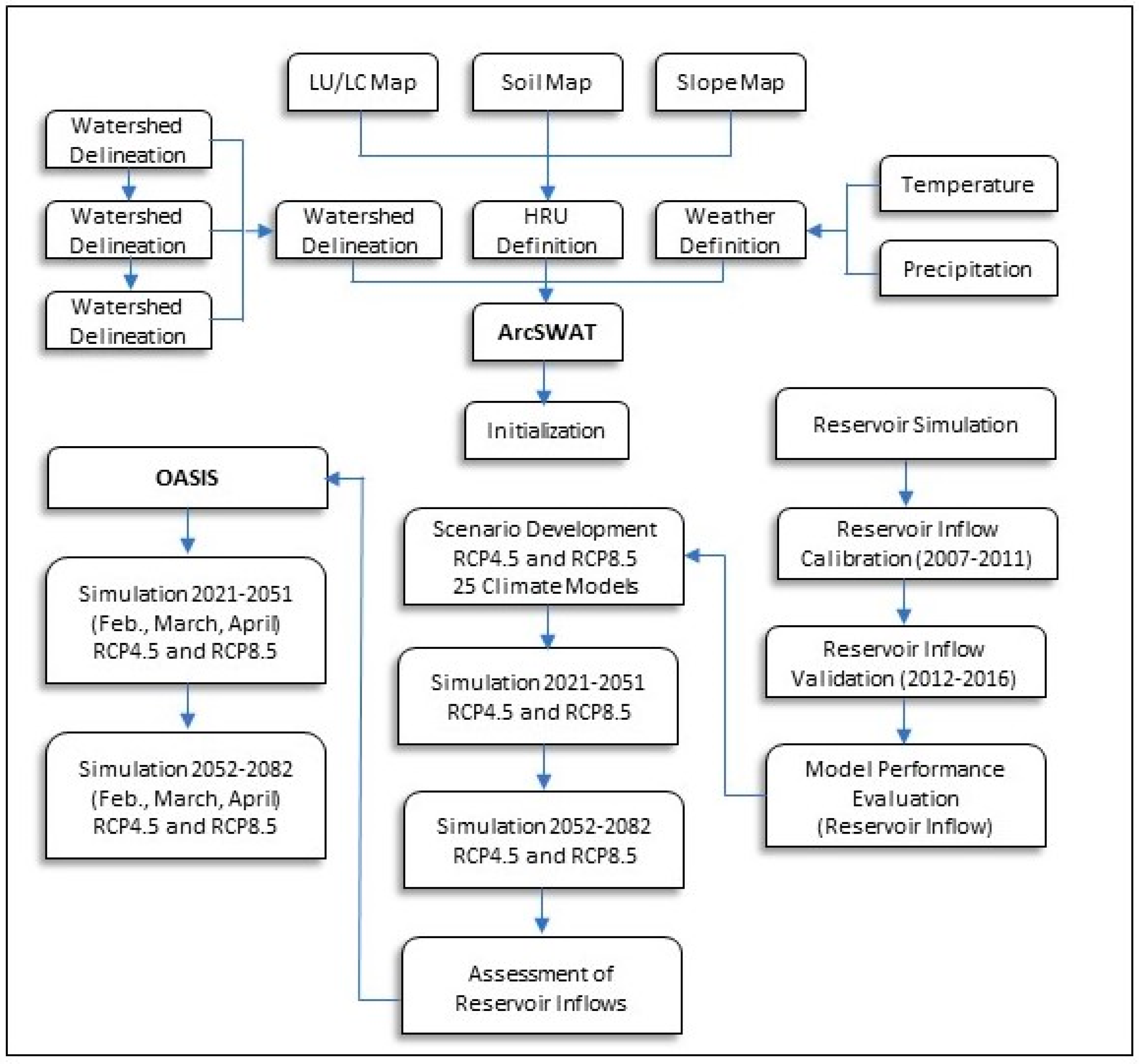
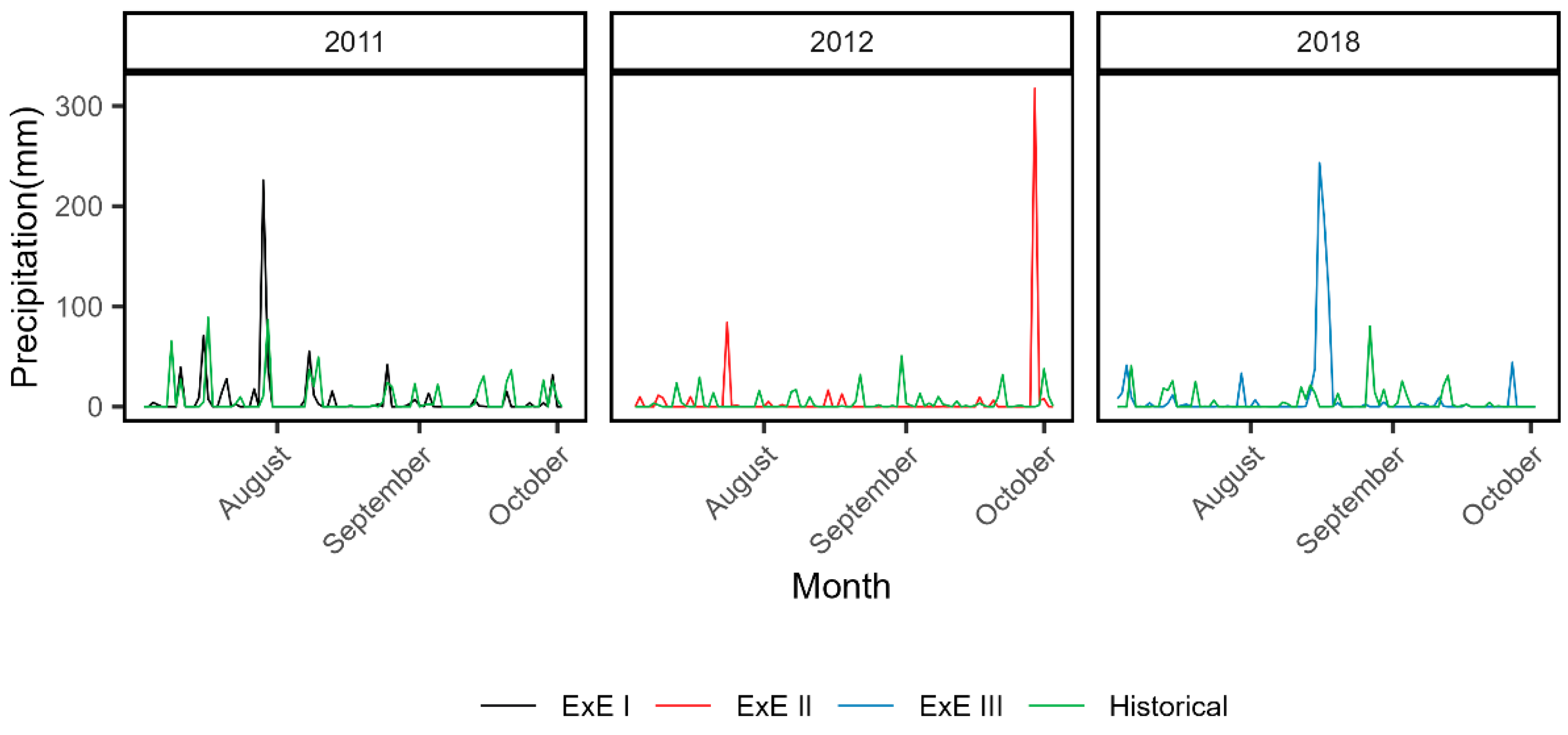

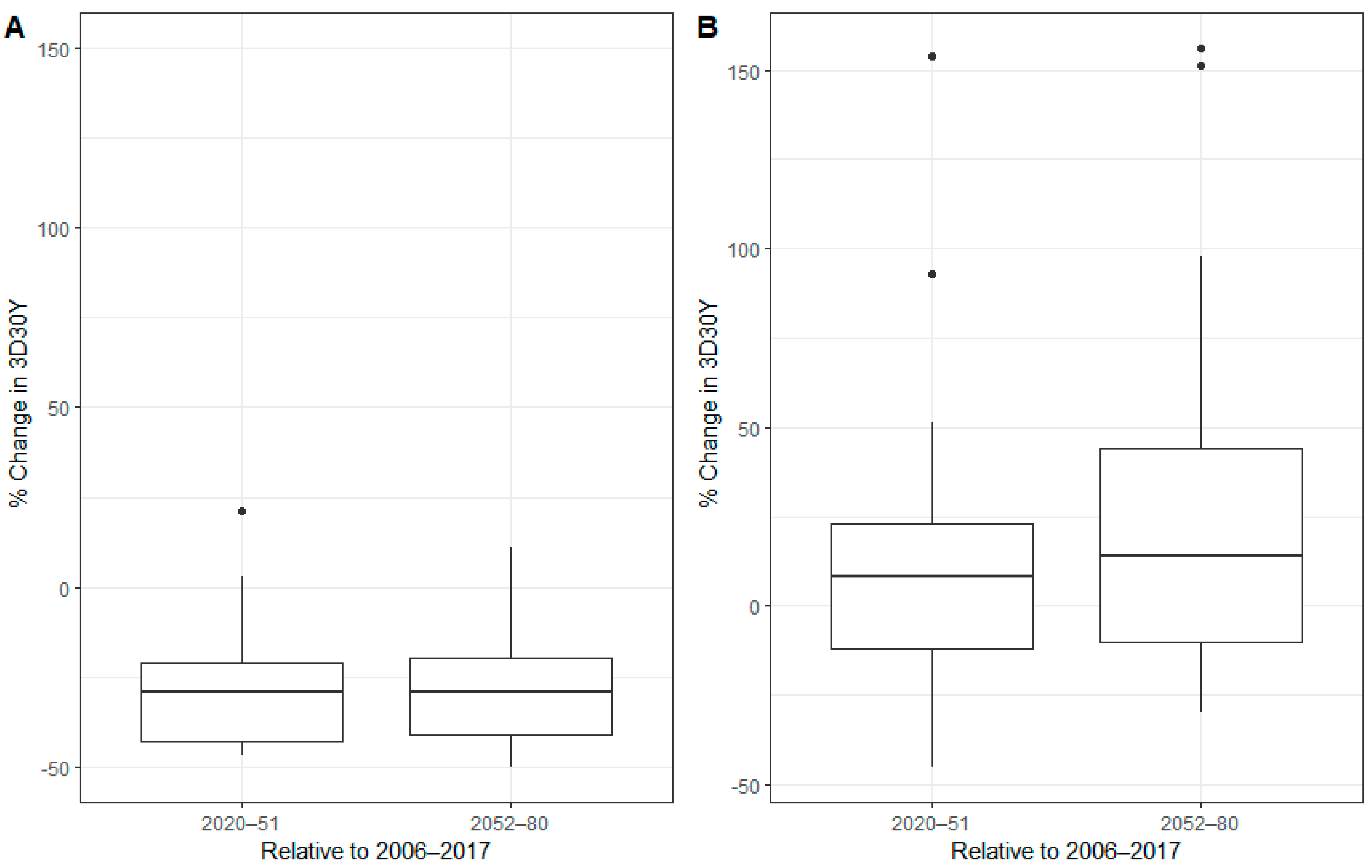
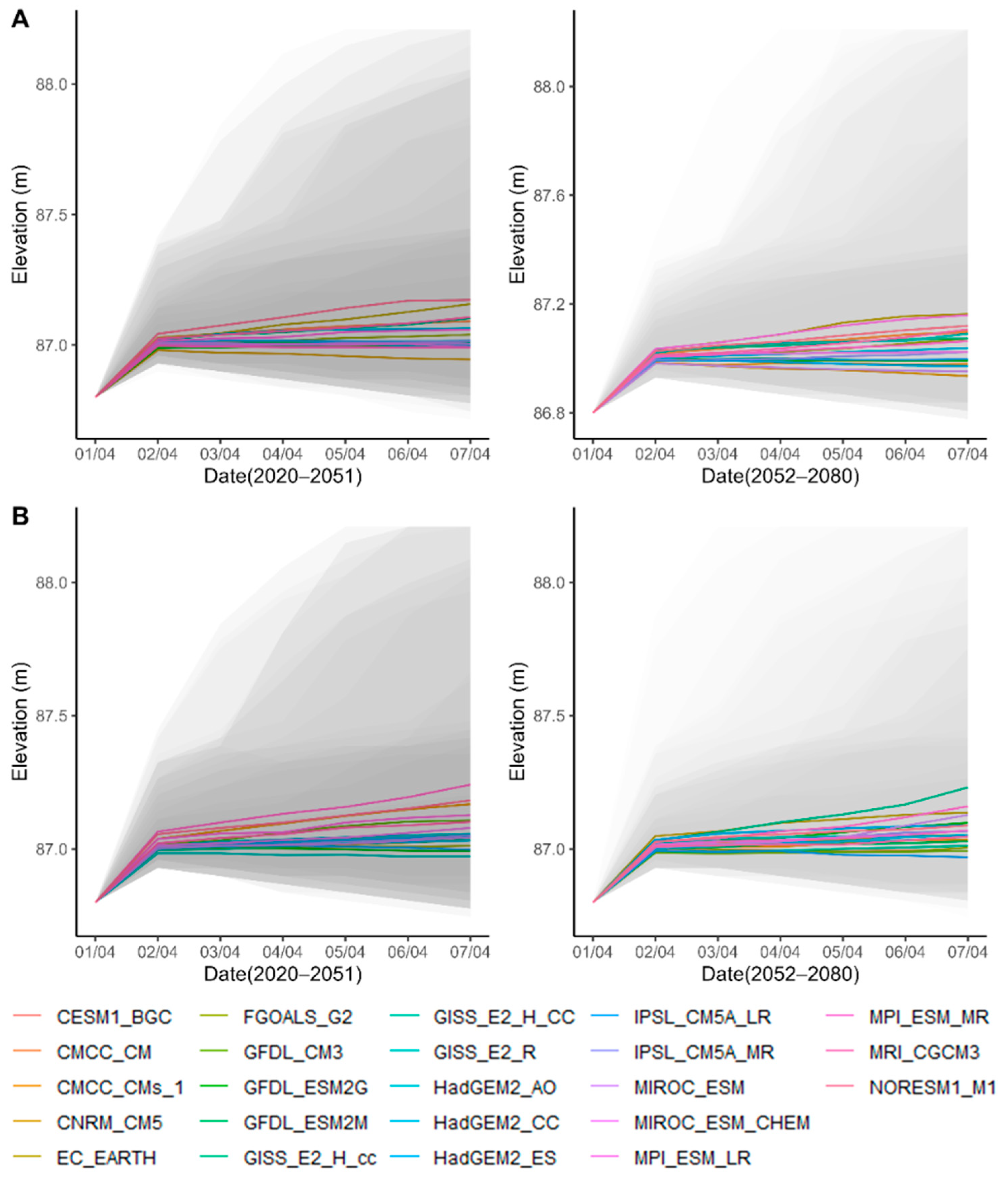
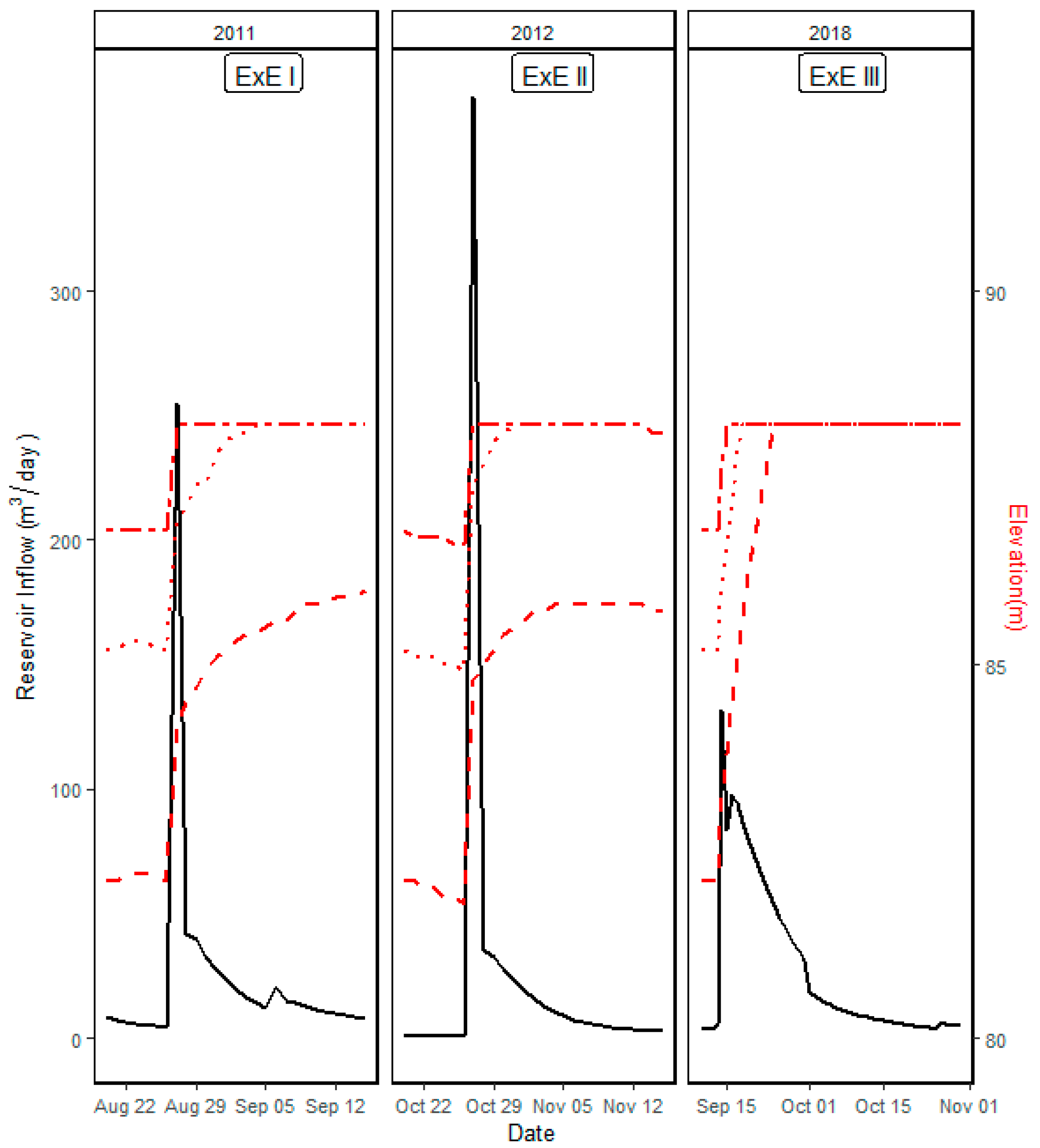
| Synthetic Hurricane ID | Actual Hurricane Name | Actual Landfall Location | Date, Year | Max. 24 h Rainfall (mm) and Event Magnitude | Total Rainfall Amount (mm) | Normal Precipitation (mm) |
|---|---|---|---|---|---|---|
| ExE I | Irene | Delaware | 26–27 August, 2011 | 226.1 (50 y) | 265 | 10.9 |
| ExE II | Sandy | Easton, MD | 27 October, 2012 | 317.5 (500 y) | 331 | 1.8 |
| ExE III | Florence | Wilmington, NC | 17 September, 2018 | 254.0 (100 y) | 584 | 0.3 |
| (a) | ||||||
| Model Name | Feb (2021–2051) | Mar (2021–2051) | April (2021–2051) | Feb (2052–2082) | Mar (2052–2082) | April (2052–2082) |
| CESM1-BGC | −6 | 13 | 18 | −11 | 5 | 44 |
| CMCC-CM | −6 | 21 | 41 | −5 | 29 | 22 |
| CNRM-CM5 | 8 | 16 | 3 | 21 | 18 | −10 |
| CSIRO-MK3 | −8 | 36 | 36 | 2 | 32 | 25 |
| EC-EARTH | −30 | −2 | 1 | −1 | 2 | 39 |
| FGOALS-G2 | −14 | 8 | −16 | 4 | 8 | 4 |
| GFDL-CM3 | −13 | −12 | −9 | 3 | 22 | −18 |
| GFDL-ESM2G | 4 | 2 | 1 | −15 | 7 | −2 |
| GFDL-ESM2M | 39 | 6 | 28 | 23 | 4 | 22 |
| GISS-E2-R | −20 | 22 | 33 | 14 | −19 | 38 |
| HadGEM2-ES | 8 | 13 | 20 | −16 | 47 | 42 |
| HadGEM2-AO | 22 | 23 | 25 | 25 | 27 | 19 |
| HadGEM2-CC | −28 | −20 | 3 | −29 | −9 | 17 |
| IPSL-CM5A-LR | −1 | 28 | 1 | 0 | 24 | 17 |
| IPSL-CM5A-MR | −13 | −12 | −8 | −16 | −23 | 27 |
| MIROC-ESM | 22 | 53 | 18 | 37 | 36 | 24 |
| MIROC-ESM-CHEM | 3 | 28 | 25 | 2 | 13 | 39 |
| MIROC5 | −22 | −17 | −19 | −6 | 2 | 8 |
| MPI-ESM-LR | 4 | 57 | 21 | 19 | 50 | 31 |
| MPI-ESM-MR | −22 | 45 | 25 | 7 | 52 | 29 |
| MRI-CGCM3 | −23 | 5 | 12 | −21 | 21 | 2 |
| NORESM1-M1 | 10 | 8 | 8 | −3 | −1 | 17 |
| CMCC-CMS_1 | −23 | −23 | 7 | −3 | −10 | 0 |
| GISS-E2-H-CC | −4 | 5 | 33 | 15 | 20 | 22 |
| (b) | ||||||
| CMCC-CMS_1 | 2 | 4 | 16 | 21 | 40 | 28 |
| CESM1-BGC | 4 | 35 | 30 | −9 | 33 | 38 |
| CMCC-CM | 9 | 48 | 34 | 4 | 56 | 25 |
| CNRM-CM5 | 16 | 24 | 10 | 21 | 37 | 7 |
| CSIRO-MK3 | 3 | 30 | 25 | −9 | 50 | 38 |
| EC-EARTH | 13 | 14 | 33 | 1 | 26 | 65 |
| FGOALS-G2 | −10 | 8 | 25 | −7 | −8 | −9 |
| GFDL-CM3 | −13 | −3 | −4 | −5 | 6 | 22 |
| GFDL-ESM2G | −19 | 15 | 17 | 1 | 5 | 28 |
| GFDL-ESM2M | −7 | −12 | 25 | 5 | 11 | 24 |
| GISS-E2-R | 17 | 15 | 13 | 31 | 1 | 27 |
| HadGEM2-ES | −24 | 13 | 5 | 9 | 58 | 21 |
| HadGEM2-AO | 7 | 19 | 37 | −8 | 3 | 27 |
| HadGEM2-CC | −10 | 23 | 89 | −8 | 36 | 56 |
| IPSL-CM5A-LR | 11 | 28 | 10 | 25 | 25 | 20 |
| IPSL-CM5A-MR | −11 | −7 | 25 | −16 | 5 | 21 |
| MIROC-ESM | 19 | 72 | 28 | 4 | 41 | 17 |
| MIROC-ESM-CHEM | 31 | 22 | 37 | 27 | 41 | 76 |
| MIROC5 | 5 | 56 | 34 | 37 | 45 | 41 |
| MPI-ESM-LR | 2 | 17 | −2 | 14 | 42 | −3 |
| MPI-ESM-MR | −25 | 47 | 7 | 3 | 44 | 1 |
| MRI-CGCM3 | −9 | 2 | 46 | 8 | 58 | 49 |
| NORESM1-M1 | −8 | 9 | −1 | 14 | 13 | 13 |
| Hurricane Scenario | Month | Average Historical Reservoir Elevation (m above NAVD88) | Average Monthly Reservoir Capacity | Simulated Flow after Hurricane (m3/s) | Change in Reservoir Capacity under Baseline Scenarios | Range of Overspill (m3/s) | ||
|---|---|---|---|---|---|---|---|---|
| IR_51 | IR_80 | IR_98 | ||||||
| ExE I | August | 85.14 | 80% | 254 | 80% | >100% | >100% | 100–110 |
| ExE II | October | 86.1 | 89% | 378 | 86% | >100% | >100% | 120–127 |
| ExE III | September | 85.65 | 85% | 132 | >100% | >100% | >100% | 122–128 |
Disclaimer/Publisher’s Note: The statements, opinions and data contained in all publications are solely those of the individual author(s) and contributor(s) and not of MDPI and/or the editor(s). MDPI and/or the editor(s) disclaim responsibility for any injury to people or property resulting from any ideas, methods, instructions or products referred to in the content. |
© 2024 by the authors. Licensee MDPI, Basel, Switzerland. This article is an open access article distributed under the terms and conditions of the Creative Commons Attribution (CC BY) license (https://creativecommons.org/licenses/by/4.0/).
Share and Cite
Paul, S.; Pradhanang, S.M.; Boving, T.B. Assessing the Hydrologic Response of a Major Drinking Water Reservoir to Extreme Flood Events and Climate Change Using SWAT and OASIS. Water 2024, 16, 2572. https://doi.org/10.3390/w16182572
Paul S, Pradhanang SM, Boving TB. Assessing the Hydrologic Response of a Major Drinking Water Reservoir to Extreme Flood Events and Climate Change Using SWAT and OASIS. Water. 2024; 16(18):2572. https://doi.org/10.3390/w16182572
Chicago/Turabian StylePaul, Supria, Soni M. Pradhanang, and Thomas B. Boving. 2024. "Assessing the Hydrologic Response of a Major Drinking Water Reservoir to Extreme Flood Events and Climate Change Using SWAT and OASIS" Water 16, no. 18: 2572. https://doi.org/10.3390/w16182572








